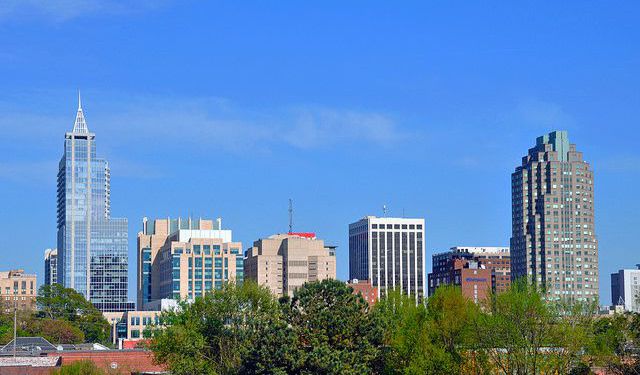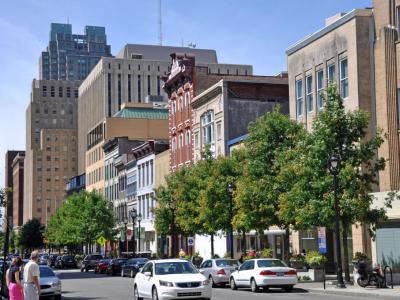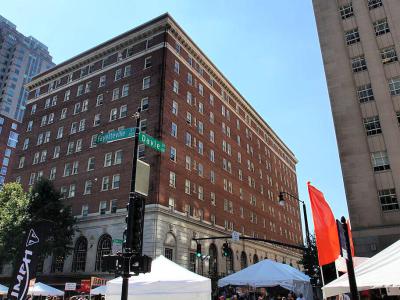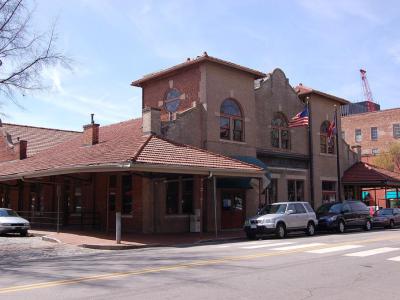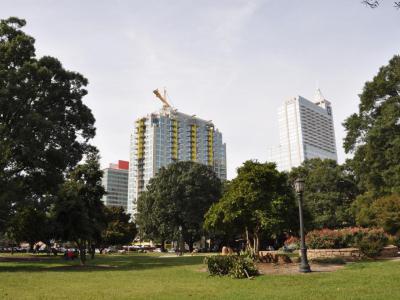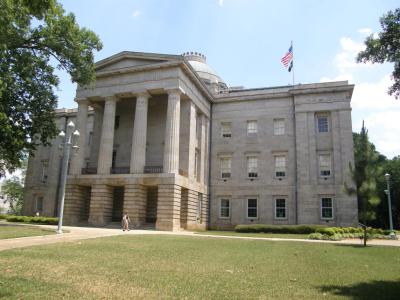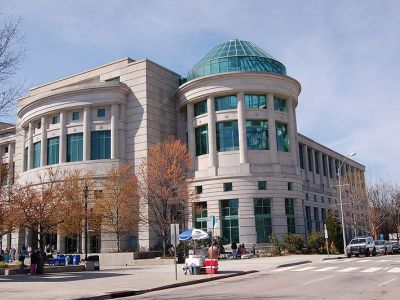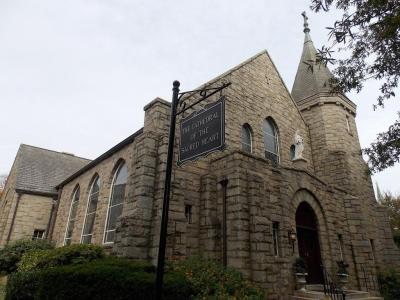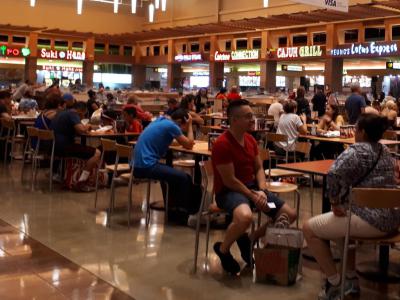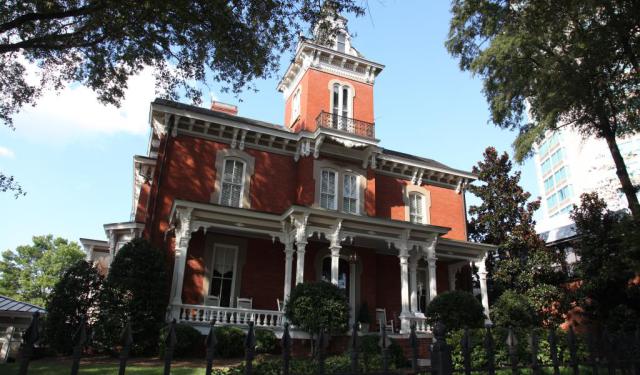Raleigh Introduction Walking Tour (Self Guided), Raleigh
Raleigh, the capital of North Carolina, is often called the "City of Oaks" because there are many oak trees there. The city's origins go back to the late 1700s and are connected to the famous English explorer Sir Walter Raleigh from the 16th century. He tried to establish the first English colony in the Americas, known as the Roanoke Colony, which is now in North Carolina.
The name "Raleigh" not only reminds us of Sir Walter Raleigh's adventurous spirit but also captures the essence of a city that has transformed from a new capital into a center of culture, knowledge, and technological innovation.
Raleigh became North Carolina's capital in 1792, replacing the previous capital, New Bern. Throughout its history, Raleigh has been influenced by different factors, including the Civil War and its aftermath, economic changes, and urban development. In the 20th century, the city grew significantly due to its role as an educational, technological, and governmental hub. Today, Raleigh is well-known for its universities and other academic institutions around the city, forming the Research Triangle.
One of Raleigh's main attractions is the Sir Walter Raleigh Hotel. It's a symbol of luxury, combining historical elegance with modern comfort. This hotel not only pays tribute to the past but also provides a luxurious experience for guests.
In the midst of the lively urban scene, the City Market stands as a tribute to Raleigh's history as a commercial center. Nearby, Moore Square offers a peaceful space for relaxation and contemplation, inviting both residents and visitors to take a break.
At the pinnacle of Raleigh's gubernatorial heritage, the North Carolina State Capitol stands majestically. Its impressive appearance represents the city's commitment to democratic values, and the important discussions and decisions made within its walls are a reflection of the leaders who have shaped the state's development.
The capital of North Carolina combines historical charm with modern energy. Whether you're walking along Fayetteville Street, immersing yourself in its iconic atmosphere, or enjoying the diverse food options at Morgan Street Food Hall, Raleigh invites you to experience its blend of tradition and modern urban life. Consider exploring this captivating city on your own and creating lasting memories.
The name "Raleigh" not only reminds us of Sir Walter Raleigh's adventurous spirit but also captures the essence of a city that has transformed from a new capital into a center of culture, knowledge, and technological innovation.
Raleigh became North Carolina's capital in 1792, replacing the previous capital, New Bern. Throughout its history, Raleigh has been influenced by different factors, including the Civil War and its aftermath, economic changes, and urban development. In the 20th century, the city grew significantly due to its role as an educational, technological, and governmental hub. Today, Raleigh is well-known for its universities and other academic institutions around the city, forming the Research Triangle.
One of Raleigh's main attractions is the Sir Walter Raleigh Hotel. It's a symbol of luxury, combining historical elegance with modern comfort. This hotel not only pays tribute to the past but also provides a luxurious experience for guests.
In the midst of the lively urban scene, the City Market stands as a tribute to Raleigh's history as a commercial center. Nearby, Moore Square offers a peaceful space for relaxation and contemplation, inviting both residents and visitors to take a break.
At the pinnacle of Raleigh's gubernatorial heritage, the North Carolina State Capitol stands majestically. Its impressive appearance represents the city's commitment to democratic values, and the important discussions and decisions made within its walls are a reflection of the leaders who have shaped the state's development.
The capital of North Carolina combines historical charm with modern energy. Whether you're walking along Fayetteville Street, immersing yourself in its iconic atmosphere, or enjoying the diverse food options at Morgan Street Food Hall, Raleigh invites you to experience its blend of tradition and modern urban life. Consider exploring this captivating city on your own and creating lasting memories.
How it works: Download the app "GPSmyCity: Walks in 1K+ Cities" from Apple App Store or Google Play Store to your mobile phone or tablet. The app turns your mobile device into a personal tour guide and its built-in GPS navigation functions guide you from one tour stop to next. The app works offline, so no data plan is needed when traveling abroad.
Raleigh Introduction Walking Tour Map
Guide Name: Raleigh Introduction Walking Tour
Guide Location: USA » Raleigh (See other walking tours in Raleigh)
Guide Type: Self-guided Walking Tour (Sightseeing)
# of Attractions: 8
Tour Duration: 2 Hour(s)
Travel Distance: 2.6 Km or 1.6 Miles
Author: karenv
Sight(s) Featured in This Guide:
Guide Location: USA » Raleigh (See other walking tours in Raleigh)
Guide Type: Self-guided Walking Tour (Sightseeing)
# of Attractions: 8
Tour Duration: 2 Hour(s)
Travel Distance: 2.6 Km or 1.6 Miles
Author: karenv
Sight(s) Featured in This Guide:
- Fayetteville Street
- Sir Walter Raleigh Hotel
- City Market
- Moore Square
- North Carolina State Capitol
- North Carolina Museum of Natural Sciences
- Cathedral of the Sacred Heart
- Morgan Street Food Hall
1) Fayetteville Street
Nestled in the heart of downtown Raleigh, Fayetteville Street stands as more than just a mere street; it's a vibrant corridor of history, culture, and community. Originally a bustling main artery in the early 20th century, Fayetteville Street was the principal route south of the state capitol. Its transformation into a pedestrian mall in 1977 marked Raleigh's determined effort to revitalize its downtown core. Thus, Fayetteville Street was reborn with even greater vitality in 2006, as it was reintroduced to vehicles, reinvigorating the area and reaffirming its status as the city's ceremonial center.
The spirit of Fayetteville Street extends beyond its architectural design and urban layout. The street has a rich legacy of hosting parades, special events, and seasonal celebrations. From the annual Holidays Parade on the Saturday before Thanksgiving to the city's vibrant New Year's Eve celebration known as First Night, Fayetteville Street serves as a hub for communal merriment. Its legacy of celebration is further enriched by the Raleigh Wide Open event, a yearly celebration that marks the reopening of the street, symbolizing Raleigh's resilience and growth.
This historic thoroughfare is not only a focal point for celebration but also a hub of commerce and culture. The Fayetteville Street district is a bustling tapestry of downtown life, home to a diverse array of businesses, boutiques, restaurants, and entertainment venues. Strolling down this vibrant corridor, one can encounter a myriad of experiences, from indulging in culinary delights to exploring unique shops and immersing oneself in the city's arts scene.
In recognition of its historical and cultural significance, the Fayetteville Street Historic District was added to the National Register of Historic Places in 2008, cementing its place as a cherished heritage site.
The spirit of Fayetteville Street extends beyond its architectural design and urban layout. The street has a rich legacy of hosting parades, special events, and seasonal celebrations. From the annual Holidays Parade on the Saturday before Thanksgiving to the city's vibrant New Year's Eve celebration known as First Night, Fayetteville Street serves as a hub for communal merriment. Its legacy of celebration is further enriched by the Raleigh Wide Open event, a yearly celebration that marks the reopening of the street, symbolizing Raleigh's resilience and growth.
This historic thoroughfare is not only a focal point for celebration but also a hub of commerce and culture. The Fayetteville Street district is a bustling tapestry of downtown life, home to a diverse array of businesses, boutiques, restaurants, and entertainment venues. Strolling down this vibrant corridor, one can encounter a myriad of experiences, from indulging in culinary delights to exploring unique shops and immersing oneself in the city's arts scene.
In recognition of its historical and cultural significance, the Fayetteville Street Historic District was added to the National Register of Historic Places in 2008, cementing its place as a cherished heritage site.
2) Sir Walter Raleigh Hotel
The Sir Walter Raleigh Hotel, an enduring landmark in Raleigh, stands as a testament to the city's rich history and the evolution of its urban landscape. Constructed between 1923 and 1924 on the vibrant Fayetteville Street, the Sir Walter Raleigh Hotel has weathered the sands of time to become the oldest surviving hotel building in the city.
Named after the legendary Sir Walter Raleigh, this hotel holds a significant place in the city's fabric. Often referred to as North Carolina's "third house of government," the hotel's strategic location and historical importance made it a focal point for state political activity well into the 1960s. Its role as a hub for political discourse and decision-making earned it a place in the hearts of the people and a unique place in history.
An embodiment of the architectural trends of the 1920s, the Sir Walter Raleigh Hotel boasts an impressive ten-story structure with an L-shaped design, characterized by a sturdy brick exterior and classical stone ornamentation adorning its street and roof levels.
The hotel's resilience was tested during the Great Depression, leading to changes in ownership and a subsequent lease to the North State Hotel Company. This transition paved the way for a major renovation and expansion, propelling the Sir Walter Raleigh Hotel to the forefront of North Carolina's convention scene. As the largest hotel in the state, it earned a reputation as a premier destination for events and gatherings.
By 1975, the building's purpose had transformed, and it became primarily occupied by offices for various entities, reflecting the shifting landscape of downtown Raleigh. Yet, the hotel's historical significance did not wane. Over the years, the building underwent various changes and adaptations. In 1978, the hotel found new life as the Sir Walter Apartments, offering comfortable living spaces for seniors.
Named after the legendary Sir Walter Raleigh, this hotel holds a significant place in the city's fabric. Often referred to as North Carolina's "third house of government," the hotel's strategic location and historical importance made it a focal point for state political activity well into the 1960s. Its role as a hub for political discourse and decision-making earned it a place in the hearts of the people and a unique place in history.
An embodiment of the architectural trends of the 1920s, the Sir Walter Raleigh Hotel boasts an impressive ten-story structure with an L-shaped design, characterized by a sturdy brick exterior and classical stone ornamentation adorning its street and roof levels.
The hotel's resilience was tested during the Great Depression, leading to changes in ownership and a subsequent lease to the North State Hotel Company. This transition paved the way for a major renovation and expansion, propelling the Sir Walter Raleigh Hotel to the forefront of North Carolina's convention scene. As the largest hotel in the state, it earned a reputation as a premier destination for events and gatherings.
By 1975, the building's purpose had transformed, and it became primarily occupied by offices for various entities, reflecting the shifting landscape of downtown Raleigh. Yet, the hotel's historical significance did not wane. Over the years, the building underwent various changes and adaptations. In 1978, the hotel found new life as the Sir Walter Apartments, offering comfortable living spaces for seniors.
3) City Market
Nestled within the historic confines of City Market, the scene is set for a delightful adventure. Cobblestone streets wind their way through the area, guiding couples hand in hand as they embark on shopping sprees that transcend time. Vintage lanterns cast a warm, nostalgic glow that paints the surroundings with a touch of romance, making it a perfect destination for a leisurely evening stroll.
The heart of City Market brims with boutiques and shops, each exuding its own distinct personality and offerings. As you explore, you'll discover a world of possibilities, from unique finds to treasured souvenirs. Dechen Collections, a haven of Tibetan authenticity, welcomes you with exotic and genuine goods that carry a piece of faraway lands. Meanwhile, Epona and Oak showcases an array of original clothing, including an eclectic assortment of tees that cater to diverse tastes.
Beyond its shopping allure, City Market boasts an array of fine dining establishments that cater to every palate. As you wander, the inviting aromas of delectable dishes waft through the air, inviting you to indulge in a culinary journey. Whether you're in the mood for a cozy meal or a sophisticated dining experience, City Market's dining scene promises to satisfy both your appetite and your craving for memorable moments.
But the magic of City Market extends beyond its charming ambiance and shopping wonders. The area pulses with vibrant energy, offering a hub of activity that keeps visitors engaged and entertained. From lively events to cultural happenings, there's always something to captivate your interest and add an extra layer of excitement to your visit.
The heart of City Market brims with boutiques and shops, each exuding its own distinct personality and offerings. As you explore, you'll discover a world of possibilities, from unique finds to treasured souvenirs. Dechen Collections, a haven of Tibetan authenticity, welcomes you with exotic and genuine goods that carry a piece of faraway lands. Meanwhile, Epona and Oak showcases an array of original clothing, including an eclectic assortment of tees that cater to diverse tastes.
Beyond its shopping allure, City Market boasts an array of fine dining establishments that cater to every palate. As you wander, the inviting aromas of delectable dishes waft through the air, inviting you to indulge in a culinary journey. Whether you're in the mood for a cozy meal or a sophisticated dining experience, City Market's dining scene promises to satisfy both your appetite and your craving for memorable moments.
But the magic of City Market extends beyond its charming ambiance and shopping wonders. The area pulses with vibrant energy, offering a hub of activity that keeps visitors engaged and entertained. From lively events to cultural happenings, there's always something to captivate your interest and add an extra layer of excitement to your visit.
4) Moore Square
Nestled within the heart of downtown Raleigh, Moore Square stands as a timeless testament to the city's rich heritage, seamlessly blending history with contemporary vibrancy. This historic district, encompassing a one-block radius around the park/square and the iconic City Market, is more than just a physical space – it's a cherished gathering spot that has evolved through the ages while retaining its central role in the city's identity.
Moore Square's recent transformation into a 21st-century space has breathed new life into the surrounding district, infusing it with a palpable energy that extends from daylight to the thriving nightlife. As you traverse its streets, you'll find yourself navigating a harmonious blend of old-world charm and modern sophistication. The juxtaposition of cobblestone streets against sleek architectural upgrades, like the state-of-the-art GoRaleigh Transit Station, reflects Raleigh's commitment to honoring its history while embracing the future.
Since its inception in 1792, Moore Square has stood as a focal point for the city's inhabitants. Its four-acre expanse has long been a nexus for community engagement, introspection, entertainment, and leisure. The park's origin dates back to Raleigh's founding, where it was envisioned as one of five public green spaces designed to provide respite and recreation for the city's residents.
Throughout its storied history, Moore Square has played host to a myriad of gatherings, each marking a unique moment in time. From historical events to modern festivals, the park has witnessed countless stories unfold against its lush backdrop. Today, it continues to be a canvas for the city's residents to paint their own narratives, embracing the echoes of the past while looking towards a future that holds endless possibilities.
Moore Square's recent transformation into a 21st-century space has breathed new life into the surrounding district, infusing it with a palpable energy that extends from daylight to the thriving nightlife. As you traverse its streets, you'll find yourself navigating a harmonious blend of old-world charm and modern sophistication. The juxtaposition of cobblestone streets against sleek architectural upgrades, like the state-of-the-art GoRaleigh Transit Station, reflects Raleigh's commitment to honoring its history while embracing the future.
Since its inception in 1792, Moore Square has stood as a focal point for the city's inhabitants. Its four-acre expanse has long been a nexus for community engagement, introspection, entertainment, and leisure. The park's origin dates back to Raleigh's founding, where it was envisioned as one of five public green spaces designed to provide respite and recreation for the city's residents.
Throughout its storied history, Moore Square has played host to a myriad of gatherings, each marking a unique moment in time. From historical events to modern festivals, the park has witnessed countless stories unfold against its lush backdrop. Today, it continues to be a canvas for the city's residents to paint their own narratives, embracing the echoes of the past while looking towards a future that holds endless possibilities.
5) North Carolina State Capitol
The North Carolina State Capitol, a resplendent symbol of history and governance, stands as a testament to the evolution of North Carolina's political landscape. Anchored at the heart of Union Square on One East Edenton Street in Raleigh, it embodies the state's journey from its early legislative endeavors to its modern governance structures.
Constructed in the wake of the 1831 fire that consumed the first North Carolina State House, the Capitol emerged as a beacon of resilience and progress. A majestic example of Greek Revival architecture, this monumental structure was meticulously built to house the state's government, encompassing all facets of governance until 1888. The legacy of the Capitol's initial purpose echoes through its hallowed halls.
In 1888, as part of the state's continued growth and evolution, the Supreme Court and State Library found their new home in a separate building, followed by the General Assembly's transition to the State Legislative Building in 1963. Today, the Capitol's corridors continue to reverberate with the workings of government, as the governor and their immediate staff occupy offices on the first floor-a living connection to its historical role.
The laying of the cornerstone, a moment rich with Masonic tradition, transpired on July 4, 1833, bestowing the Capitol with a profound sense of purpose and promise. Constructed with dedication and artistry, the building's Greek Revival architecture is a tribute to classical aesthetics, standing as a testament to the era's architectural sophistication and symbolism.
Remarkably, the Capitol has maintained its essential character since its completion in 1840. While time has left its marks, including the minor remodeling of three rooms, the building's core essence remains unaltered. Designated a National Historic Landmark in 1973, the North Carolina State Capitol is a living repository of North Carolina's past and a testament to its forward momentum.
Constructed in the wake of the 1831 fire that consumed the first North Carolina State House, the Capitol emerged as a beacon of resilience and progress. A majestic example of Greek Revival architecture, this monumental structure was meticulously built to house the state's government, encompassing all facets of governance until 1888. The legacy of the Capitol's initial purpose echoes through its hallowed halls.
In 1888, as part of the state's continued growth and evolution, the Supreme Court and State Library found their new home in a separate building, followed by the General Assembly's transition to the State Legislative Building in 1963. Today, the Capitol's corridors continue to reverberate with the workings of government, as the governor and their immediate staff occupy offices on the first floor-a living connection to its historical role.
The laying of the cornerstone, a moment rich with Masonic tradition, transpired on July 4, 1833, bestowing the Capitol with a profound sense of purpose and promise. Constructed with dedication and artistry, the building's Greek Revival architecture is a tribute to classical aesthetics, standing as a testament to the era's architectural sophistication and symbolism.
Remarkably, the Capitol has maintained its essential character since its completion in 1840. While time has left its marks, including the minor remodeling of three rooms, the building's core essence remains unaltered. Designated a National Historic Landmark in 1973, the North Carolina State Capitol is a living repository of North Carolina's past and a testament to its forward momentum.
6) North Carolina Museum of Natural Sciences (must see)
Nestled within the heart of Raleigh, the North Carolina Museum of Natural Sciences (NCMNS) stands as a beacon of scientific exploration and wonder, beckoning visitors to embark on a captivating journey through the natural world. As the oldest established museum in the state and the largest of its kind in the Southeastern United States, the NCMNS has earned its place as a cherished institution that ignites curiosity and fosters a deeper understanding of the world around us.
With approximately 1.2 million visitors annually, the museum holds the distinction of being the state's most popular destination for both residents and visitors alike. Its captivating exhibits, engaging programs, and comprehensive collections draw in enthusiasts of all ages, making it a cherished hub of learning and inspiration.
The seeds of the North Carolina Museum of Natural Sciences were sown in 1879, when the North Carolina State Museum was born. This birth was the result of merging two existing state-owned collections of geologic and agricultural specimens. Initially housed within the Briggs building on Fayetteville Street, the museum's journey of growth and transformation had begun.
Over the course of the following 60 years, the museum's stature expanded significantly. Its collections evolved to encompass a staggering variety of natural specimens, ranging from amphibians and reptiles to birds, fish, mammals, invertebrates, fossils, plants, geology, and meteorites. This rich diversity of exhibits reflects the multifaceted tapestry of Earth's ecosystems and history.
Whether you're captivated by the mysteries of deep-sea life, fascinated by the wonders of evolution, or intrigued by the intricacies of ecosystems, the museum's carefully curated exhibits offer a window into the extraordinary diversity of life on our planet.
The admission is free.
With approximately 1.2 million visitors annually, the museum holds the distinction of being the state's most popular destination for both residents and visitors alike. Its captivating exhibits, engaging programs, and comprehensive collections draw in enthusiasts of all ages, making it a cherished hub of learning and inspiration.
The seeds of the North Carolina Museum of Natural Sciences were sown in 1879, when the North Carolina State Museum was born. This birth was the result of merging two existing state-owned collections of geologic and agricultural specimens. Initially housed within the Briggs building on Fayetteville Street, the museum's journey of growth and transformation had begun.
Over the course of the following 60 years, the museum's stature expanded significantly. Its collections evolved to encompass a staggering variety of natural specimens, ranging from amphibians and reptiles to birds, fish, mammals, invertebrates, fossils, plants, geology, and meteorites. This rich diversity of exhibits reflects the multifaceted tapestry of Earth's ecosystems and history.
Whether you're captivated by the mysteries of deep-sea life, fascinated by the wonders of evolution, or intrigued by the intricacies of ecosystems, the museum's carefully curated exhibits offer a window into the extraordinary diversity of life on our planet.
The admission is free.
7) Cathedral of the Sacred Heart
Known colloquially as Cathedral of the Sacred Heart, this magnificent edifice serves as the spiritual epicenter of the Roman Catholic Diocese of Raleigh, embodying both reverence and grandeur. The cathedral's history is intertwined with the growth of Catholicism in North Carolina. Prior to 1924, the state was the only one in the United States without its own Catholic diocese. The establishment of the Sacred Heart Cathedral marked a pivotal moment in the state's religious landscape, filling a significant void and providing a spiritual home for the faithful.
The cathedral's imposing neo-gothic stone structure is a sight to behold. At its entrance, a statue of Jesus Christ gazes forth, symbolizing the essence of love, sacrifice, and the spiritual journey that unfolds within its walls. The cornerstone, laid in 1922, heralded the beginning of a journey that culminated in its dedication in October 1924.
The metamorphosis from Sacred Heart Church to Sacred Heart Cathedral marked a historic transition, with the cathedral becoming the focal point of the newly created Diocese of Raleigh in December 1924. The Most Reverend William Hafey of Baltimore was appointed as its first bishop, marking a new era for Catholicism in the region.
The cathedral's interior, a sanctuary of serenity and reflection, has witnessed numerous renovations over the years. In 1939, the installation of terrazzo floors and exquisite stained glass windows enhanced its ethereal beauty. Marble altars and reredos were later added, imbuing the space with a sense of sacred grandeur.
A sensitive and artistic restoration in 1998 breathed new life into the cathedral's interior, preserving its historical essence while ensuring its spiritual relevance for generations to come. Subsequent improvements in the following years have lovingly and painstakingly returned the cathedral's interior to its 1939 glory, offering visitors a glimpse into the past while fostering a sense of spiritual connection.
The cathedral's imposing neo-gothic stone structure is a sight to behold. At its entrance, a statue of Jesus Christ gazes forth, symbolizing the essence of love, sacrifice, and the spiritual journey that unfolds within its walls. The cornerstone, laid in 1922, heralded the beginning of a journey that culminated in its dedication in October 1924.
The metamorphosis from Sacred Heart Church to Sacred Heart Cathedral marked a historic transition, with the cathedral becoming the focal point of the newly created Diocese of Raleigh in December 1924. The Most Reverend William Hafey of Baltimore was appointed as its first bishop, marking a new era for Catholicism in the region.
The cathedral's interior, a sanctuary of serenity and reflection, has witnessed numerous renovations over the years. In 1939, the installation of terrazzo floors and exquisite stained glass windows enhanced its ethereal beauty. Marble altars and reredos were later added, imbuing the space with a sense of sacred grandeur.
A sensitive and artistic restoration in 1998 breathed new life into the cathedral's interior, preserving its historical essence while ensuring its spiritual relevance for generations to come. Subsequent improvements in the following years have lovingly and painstakingly returned the cathedral's interior to its 1939 glory, offering visitors a glimpse into the past while fostering a sense of spiritual connection.
8) Morgan Street Food Hall
Nestled within the vibrant fabric of Raleigh, the Morgan Street Food Hall stands as a culinary haven, inviting visitors to embark on a gastronomic adventure like no other. Since its inception in the summer of 2018, this innovative culinary destination has redefined the dining experience, offering a dynamic assortment of flavors under one roof in a repurposed warehouse that exudes an industrial charm.
The Morgan Street Food Hall embodies the essence of community, culture, and cuisine. This one-of-a-kind in-door food market boasts a sprawling 22,000-square foot space, where local chefs, restaurateurs, and purveyors converge to celebrate their passion for food. With more than 20 culinary concepts nestled within its walls, the food hall becomes a tapestry of diversity, offering an expansive array of ethnic foods that cater to every palate.
What sets this culinary haven apart is its unique lifestyle dining concept. It encourages the art of cross meal ordering, allowing visitors to curate their dining experience by enjoying various dishes in a shared seating area. Each food stall and freestanding kiosk is a gateway to a different culinary journey, offering everything from cooked-to-order meals and snacks to delectable desserts and specialty items.
Within the confines of the food hall, an enticing world of flavors awaits. From the fiery spices of Indian cuisine at Curry in a Hurry to the freshness of Cousins Maine Lobster's lobster rolls, every bite is an invitation to explore global gastronomy. Savor Japanese, Lebanese, Mediterranean, and more, complemented by unique offerings such as Thai rolled ice cream and a plethora of culinary-related items available for purchase.
The ambiance is an elegant blend of vibrant and neutral tones, wood and brick, leather and metal-an ode to industrial chic. The exposed HVAC and steel beams imbue the space with an authentic urban aesthetic, creating an environment that perfectly complements the culinary adventure that awaits within.
The Morgan Street Food Hall embodies the essence of community, culture, and cuisine. This one-of-a-kind in-door food market boasts a sprawling 22,000-square foot space, where local chefs, restaurateurs, and purveyors converge to celebrate their passion for food. With more than 20 culinary concepts nestled within its walls, the food hall becomes a tapestry of diversity, offering an expansive array of ethnic foods that cater to every palate.
What sets this culinary haven apart is its unique lifestyle dining concept. It encourages the art of cross meal ordering, allowing visitors to curate their dining experience by enjoying various dishes in a shared seating area. Each food stall and freestanding kiosk is a gateway to a different culinary journey, offering everything from cooked-to-order meals and snacks to delectable desserts and specialty items.
Within the confines of the food hall, an enticing world of flavors awaits. From the fiery spices of Indian cuisine at Curry in a Hurry to the freshness of Cousins Maine Lobster's lobster rolls, every bite is an invitation to explore global gastronomy. Savor Japanese, Lebanese, Mediterranean, and more, complemented by unique offerings such as Thai rolled ice cream and a plethora of culinary-related items available for purchase.
The ambiance is an elegant blend of vibrant and neutral tones, wood and brick, leather and metal-an ode to industrial chic. The exposed HVAC and steel beams imbue the space with an authentic urban aesthetic, creating an environment that perfectly complements the culinary adventure that awaits within.
Walking Tours in Raleigh, North Carolina
Create Your Own Walk in Raleigh
Creating your own self-guided walk in Raleigh is easy and fun. Choose the city attractions that you want to see and a walk route map will be created just for you. You can even set your hotel as the start point of the walk.
Historic Buildings Walking Tour
As you traverse the streets of North Carolina's capital Raleigh, you cannot help noticing a wealth of historic buildings, each illustrating a chapter in the city's annals.
Among these revered structures, the Joel Lane House emerges as a cherished relic of the distant past; its venerable walls echo with the whispers of bygone eras. The Dodd-Hinsdale House, a stately emblem of... view more
Tour Duration: 2 Hour(s)
Travel Distance: 3.7 Km or 2.3 Miles
Among these revered structures, the Joel Lane House emerges as a cherished relic of the distant past; its venerable walls echo with the whispers of bygone eras. The Dodd-Hinsdale House, a stately emblem of... view more
Tour Duration: 2 Hour(s)
Travel Distance: 3.7 Km or 2.3 Miles
The Most Popular Cities
/ view all
